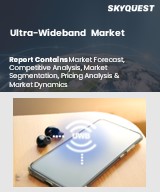
Report ID: SQMIG45I2201

Report ID:
SQMIG45I2201 |
Region:
Global |
Published Date: May, 2024
Pages:
197
|
Tables:
92 |
Figures:
75
Drivers
The demand for high-speed data transmission
The growing use of UWB in real-time positioning systems, or RTLS
Expansion in the automotive industry
IoT ecosystem expansion
Standardization and Regulatory Support
New applications are coming
Restraints
Regulatory barriers
Interference
Cost
Compatibility
Limited awareness and understanding
Competition from Alternative Technologies
Our industry expert will work with you to provide you with customized data in a short amount of time.
REQUEST FREE CUSTOMIZATIONWant to customize this report? This report can be personalized according to your needs. Our analysts and industry experts will work directly with you to understand your requirements and provide you with customized data in a short amount of time. We offer $1000 worth of FREE customization at the time of purchase.

Report ID: SQMIG45I2201